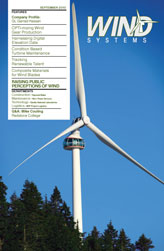It is never a pretty sight to see a wind turbine collapse. Whether it is material fatigue, defective parts, or severe weather that play a role, the fall is likely to be its final act, sending 200 tons of technology crashing to complete destruction.
The industry landscape is mottled with such catastrophic turbine failures in recent years, with some gathering more visibility than others due to public safety concerns and a need to determine the failure mode. While the jury remains out on a few, others can point to material fatigue or induced stresses beyond design limits that caused bolted joints to fail and turbines to self destruct. It is always important to determine the contributors to these incidents, and to what extent the installation process and ongoing maintenance may play in preventing them.
High-strength bolts are used on nearly all wind turbine major component assemblies including base and tower sections, blades, hubs, and main shafts. Such bolting is complex mechanically engineered hardware using different materials and thread types, assorted lengths, a variety of coatings, various classes of fit, and multiple grades.
For preloaded joints the turbine manufacturer must specify the correct bolt, lubrication, torque or tension value, and assembly method for each bolted component in order to assure the optimum operating life of the bolted connection. Equally important at the construction site is proper storage of turbine components and bolting, torque or tensioning tool calibration, and adherence to the assembly procedure. Premature failure of the connection can happen when any of these critical steps are overlooked.
An international standard, ISO 898, defines the mechanical and physical properties for metric fasteners and provides the basis for ATSM (American Society for Testing and Materials) standards that apply to U.S. manufacturers of high tensile bolting. In Europe two series of product standards—the HR (British/French) and the HV (German) systems—apply, and these bolt markings may be found on most installed wind turbines today that originated from European countries.
Regardless of the country of origin, the standards exist to ensure consistent methodology for determining critical aspects of preloaded bolting assemblies.
An obvious application for wind turbine use, preloaded bolts are advantageous if vibration is present, if slip between joining parts must be avoided, and if the applied load through the joint frequently changes from positive to a negative value, as is found in blade bolting.
For a construction site, OEMs specify proper storage requirements for all bolting assemblies. The term “protected storage” is specified with the intent that the condition of the components be maintained as nearly as possible to the as-manufactured condition until they are installed in the turbine.
This means the bolt assemblies should be stored in closed containers to protect them from dirt and corrosion, the closed containers should be stored in a protected shelter and removed only when needed, and any unused components should promptly be returned to the protected storage. Why all this special handling? Because the surface finish of a bolt, particularly with or without corrosion and lubrication, plays a determinant role on the clamping load.
To fully appreciate the relationship between a torque and the tension applied to the bolted joint, keep in mind that torque measures resistance to turning. Torque wrenches do not give a direct measurement of the clamping force of the bolt, and their readings are affected by such things as dirt, surface finish, and lubrication.
Corrosion in the form of friction can translate into higher torque readings, actually creating a condition where the bolt is not properly tightened and causing failures by allowing a joint to come loose. It may also allow the joint to flex and thus fail under fatigue. Conversely, thread lubrication is a crucial OEM specification that reduces torque values, sometimes by as much as 25 percent. With such a broad topic to cover, we’ll continue our discussion of bolting applications in the October issue of Wind Systems magazine.
































